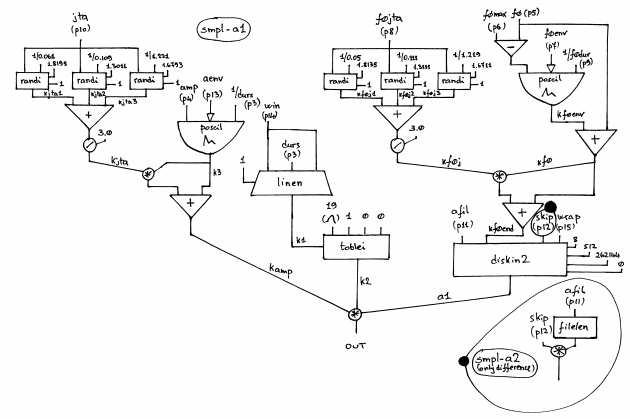Reading from a Sound file with SMPL-A2
Tutorial SMPL-A2
Name | Description | Default value |
|---|---|---|
amp | Maximum Amplitude. Linear from >0.0 to 1000 or in dB from 0 to -∞ (see Tutorial Getting Started 02 - Amplitude and Internal Editor for more details) | 0.0 |
f0 | Minimum value of the pitch transposition of input sound by this factor (e.g. 0.5 means one octave lower, 2 is one octave higher, and 1 is the original pitch). Fractional and negative values are allowed (the latter results in playing the file backwards) | -2.0 |
f0max | Maximum value of the pitch transposition of input sound by this factor . | -1.0 |
f0env | Envelope of the pitch transposition between f0 and f0max | Instance: GEN07 |
f0jta | Jitter's amplitude of the fundamental frequency [% of f0] | 0.1 |
f0dur | Duration of the envelope of the pitch transposition [sec, if 0, take global duration] | 0 |
jta | Amplitude of the jitter/random source [%] | 0.5 |
afil | Audio file [name, with possible path, sound, string, pathname or GEN01] | File: santuri_96 |
skip | (Minimum) starting point when reading an audio file [%] | 1.0 |
aenv | Amplitude Envelope [GEN] | Instance: GEN07 |
win | Attack and decay time in [sec] | 0.01 |
wrap | Wrap flag: 0=locations beyond EOF produce silence, <>0=wrap from beg of file | 1 |
The SMPL-A2 Class is a Sampler similar to SMPL-A1 with the following controls:
- The main ampllitude,
- The transposition range,
- The transposition envelope by means of a GEN routine,
- The frequency of the transposition envelope,
- The range and amplitude of the jitter of the frequency,
- The starting point of the audio file,
- The amplitude envelope by means of a GEN routine,
- The attack and decay time of the total duration of the amplitude envelope,
- The wrapping mode (enable or disable)
The only different between SMPL-A1 and SMPL-A2 is the skipping allocation. In SMPL-A1 the skip time is set to an absolute value (e.g. in seconds), instead in SMPL-A2 is set in relative value as a percentage and that is really useful for reverse playing.
The example A employs the SMPL-A2 instead the example B employs SMPL-A1 with the same given data. How you can see the difference is the relative skip time of SMPL-A2. Notice what happens when f0 and f0max are of opposite sign. The audio file is read starting from the skip point in one direction for the half time of the total duration after that come back to the skip point for the second half time.
The meaning of the other slots is the same as the SMPL-A1 Class. So see the Tutorial SMPL-A1 for more details.
For the red patch C#ed and Synt see Appendix A
Inside the Class
instr 1
idur = p3
idurosc = 1/idur
iamp = (p4 > 0.0 ? (p4*0.001) : (10 ^ (p4/20.0)))
; amplitude relative to the sound file (to avoid multiplying twice)
if0min = p5 ; min transposition factor
if0max = p6
if0d = if0max-if0min
if0env = p7
if0jt = p8
if0dur = (p9 > 0.0 ? p9 : idur)
ijta = p10
ifile = p11
ilen filelen ifile
itmpsk = p12*ilen
iskip = (itmpsk < 0.0 ? (itmpsk*if0min) : itmpsk)
; to make the value not depend on the xposition factor if it's negative
print iskip
iaenv = p13 ; global amplitude envelope
iwin = (p14 > idur/2 ? idur/2 : p14) ; local envelope
iwout = iwin
iwrap = p15
ixmode = 1 ; index between 0 and 1
ixoff = 0 ; index offset
ixrap = 0 ; no wraparound in table reading
iformat = 8 ; 24-bit int, ignored if the sound file has a header
iwsize = 512 ; the bigger, the better the quality of the transposition
ibufsize = 262144 ; maximum = 1048576, higher makes less disk access
iskipinit = 0 ; do not skip initialization
isize = 1 ; 31-bit random number for randi
iaudiofun = 1
isigfun = 19 ; sigmoid function
;f0
; jitter for f0
; seed>1.0=> seed from the system time
kf0j1 randi if0jt, 1/0.05, 1.8135, isize
kf0j2 randi if0jt, 1/0.111, 1.3111, isize
kf0j3 randi if0jt, 1/1.219, 1.6711, isize
kf0j = (kf0j1+kf0j2+kf0j3)/3.0
;f0 envelope
kf0env poscil if0d, 1/if0dur, if0env
kf0 = kf0env+if0min
kf0end = kf0+(kf0*kf0j)
; local envelope (for the grain)
k1 linen 1,iwin,idur,iwout
k2 tablei k1,isigfun,ixmode,ixoff,ixrap
; jitter for amp
; seed>1.0=> seed from the system time
kjta1 randi ijta, 1/0.061, 1.8195, isize
kjta2 randi ijta, 1/0.109, 1.3011, isize
kjta3 randi ijta, 1/1.221, 1.6793, isize
kjta = (kjta1+kjta2+kjta3)/3.0
; global envelope
k3 poscil iamp, idurosc, iaenv
kamp = k3+(k3*kjta)
; file reading
a1 diskin2 ifile, kf0end, iskip, iwrap, iformat, iwsize, ibufsize, iskipinit
asound = a1*k2*kamp
outc asound
endin
- OMChroma User Manual
- System Configuration and Installation
- Getting started
- Managing GEN function and sound files
- Predefined Classes
- User-fun
- Creating a new Class
- Multichannel processing
- Appendix A - Common Red Patches


